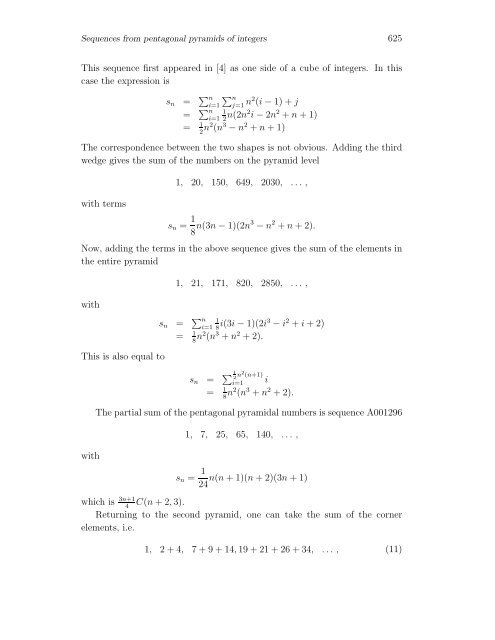Sequences from Pentagonal Pyramids of Integers - HIKARI Ltd
Sequences from Pentagonal Pyramids of Integers - HIKARI Ltd
Sequences from Pentagonal Pyramids of Integers - HIKARI Ltd
Create successful ePaper yourself
Turn your PDF publications into a flip-book with our unique Google optimized e-Paper software.
<strong>Sequences</strong> <strong>from</strong> pentagonal pyramids <strong>of</strong> integers 625<br />
This sequence first appeared in [4] as one side <strong>of</strong> a cube <strong>of</strong> integers. In this<br />
case the expression is<br />
s n = ∑ n<br />
∑ n<br />
i=1 j=1 n2 (i − 1) + j<br />
= ∑ n 1<br />
i=1 2 n(2n2 i − 2n 2 + n +1)<br />
= 1 2 n2 (n 3 − n 2 + n +1)<br />
The correspondence between the two shapes is not obvious. Adding the third<br />
wedge gives the sum <strong>of</strong> the numbers on the pyramid level<br />
with terms<br />
1, 20, 150, 649, 2030, ... ,<br />
s n = 1 8 n(3n − 1)(2n3 − n 2 + n +2).<br />
Now, adding the terms in the above sequence gives the sum <strong>of</strong> the elements in<br />
the entire pyramid<br />
with<br />
This is also equal to<br />
with<br />
1, 21, 171, 820, 2850, ... ,<br />
s n = ∑ n 1<br />
i=1<br />
i(3i − 8 1)(2i3 − i 2 + i +2)<br />
= 1 8 n2 (n 3 + n 2 +2).<br />
s n = ∑ 1<br />
2 n2 (n+1)<br />
i=1 i<br />
= 1 8 n2 (n 3 + n 2 +2).<br />
The partial sum <strong>of</strong> the pentagonal pyramidal numbers is sequence A001296<br />
1, 7, 25, 65, 140, ... ,<br />
s n = 1 n(n + 1)(n + 2)(3n +1)<br />
24<br />
which is 3n+1 C(n +2, 3).<br />
4<br />
Returning to the second pyramid, one can take the sum <strong>of</strong> the corner<br />
elements, i.e.<br />
1, 2+4, 7+9+14, 19 + 21 + 26 + 34, ... , (11)
















